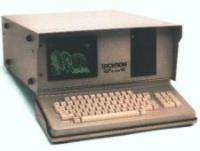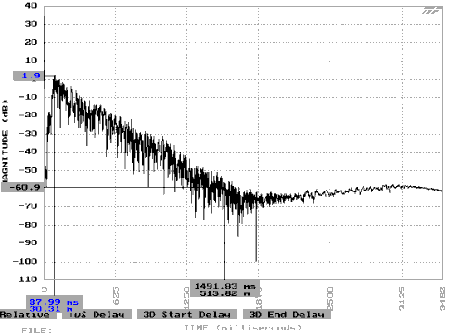
Main Page |
Time / Energy / Frequency Analysis
Time, energy and frequency are the three degrees of freedom of a sound wave. To fully measure the behaviour of sound, you need to be able to see what the frequency content (or sound spectrum) is, and how that spectrum changes in energy level over time. Clap your hands in a room, and you hear the sound from your hands plus all the sound bouncing off the walls, floors and ceilings. If you just wanted to know what the sound spectrum of your hand clap was, ignoring all those reflections, you could go stand on a hill top to make sure there were no reflections and take a measurement of it there, but that is not always convenient to do. What if you really just wanted to see how the sound spectrum dropped off in the room after the hand clap. That's much harder, you could have somebody start a measurement the instant after you clapped your hand, but that can be tough to organize, especially if your hands are the only ones there. Another problem arises because some measurement systems don't gather information fast enough to tell you much before the sound stops bouncing around.  Ideally you would like to be able to make a measurement of the frequency spectrum at any point in time, and be able to decide how long a time period you want to measure. To accomplish that, we use a TEF analyser, TEF standing for Time/Energy/Frequency. It uses a known signal to stimulate a system to be measured (DUT or Device Under Test in jargonspeak), and measures how the DUT changes the signal. The DUT can be a piece of electronic equipment (electronic signals take time to get through equipment, more than you'd think), or a sound system in a room. We can selectively measure the very first sound (direct arrival) of a sound system (like the hand clap example above), or we can measure the decay of the sound in the room (reflections or reverberation time). We can also include any amount of reflections with a measurement of the direct sound arrival to objectively measure the combination of sound that will arrive at the listener's ears after bouncing off the seats, walls and floors around the listener.  This measurement flexibility allows us to determine whether the problems in a sound system are caused by an anomaly in the loudspeakers, or are caused by reflections from nearby surfaces. We can also measure the effects of equalization on the sound system by itself, rather than having all the room reflections added in to the measurement, as happens with a conventional Real Time Analyser (or RTA). We can also measure time offset directly, which allows us to check the settings of digital signal delays for underbalcony and infill systems, and signal alignment delays in loudspeaker clusters. The TEF was used for the measurements in this cluster case study. The TEF has additional software that allows us to make measurements of the polar response of loudspeakers, acoustical measurements such as 3D arrival time (polar energy time curves), musical acoustics criterion and other useful elements of our business. We consider the TEF analyser to be an acoustic polygraph test for sound systems and rooms. The TEF has other uses, including examination of unique electro-acoustical situations, including ADR for post production. |
